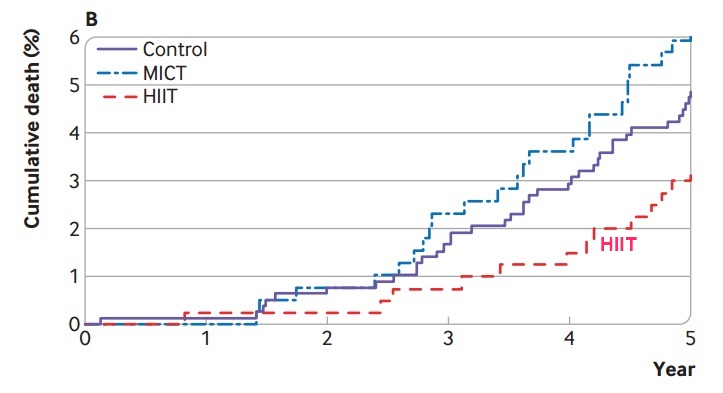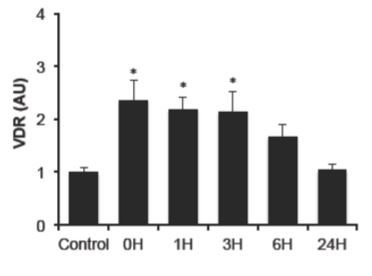Intense exercise increases vitamin D receptor activation
VDR decreases with age, acute exercise increases VDR for all ages – April 2021
Exercise acutely increases vitamin D receptor (VDR) expression in T-lymphocytes in vitamin D deficient men, independent of age
Exp Physiol. 2021 Apr 6. doi: 10.1113/EP089480
Hannah Lithgow 1 2, Geraint Florida-James 2, Mark Ross 2, Gary Duncan 3, Melanie Leggate 2
New findings: What is the central question of the study? Does exercise affect vitamin D receptor expression in T-lymphocytes in young, middle aged and older adults? What is the main finding and its importance? Moderate intensity cycling exercise increases vitamin D receptor expression in vitamin D deficient men, independent of age, presenting a strategy to combat the vitamin D epidemic.
Abstract: Vitamin D plays a key role in the modulation of the immune system, mediated through the intracellular vitamin D receptor (VDR). Exercise has been shown to influence the activity and availability of the VDR. This study aimed to investigate the effect of age on basal immune cell (T-lymphocytes) VDR expression and the subsequent effect of acute aerobic exercise to modulate VDR expression in peripheral T-cells.
Thirty-five males were included in the study (means ± SD: age 44 ± 17 y, BMI 25.7 ± 3.1 kg·m-2 ), separated into three age groups: 18-30 y (n = 12), 31-45 y (n = 11), and 60-75 y (n = 12). Participants completed two trials: control (CON) and aerobic exercise (AE), with blood samples collected pre- and post-exercise (0 h, 1 h, and 3 h). Peripheral blood T-cells were isolated and analysed for VDR expression by flow cytometry.
The results show that advanced age is associated with lower VDR expression in T-cells (882 ± 274 vs 796 ± 243 vs 594 ± 174 geomean).
Acute AE was successful at acutely increasing VDR expression in T-cells, irrespective of age.
Advanced age corresponds to a lower T cell VDR expression, which may be responsible for age-associated development of chronic conditions and autoimmunity. Exercise was successful in increasing VDR expression in T-cells irrespective of age and independent of exercise-induced T cell mobilisation.
High Intensity Interval Training decreased death rate by 50% - RCT Dec 2020
Norway: 5 year study of healthy people aged 70-77
Four 4 minute intense sessions with 4 minutes cooling off between sessions
= 36 minutes, twice a week @ 90% of heart rate
vs the same total of 150 minutes a week at 70% of heart rate
Only 50% followed the HIIT program, but on average it had excellent benefit

Note: Probably much larger benefits for average person who keeps with it.
No mention of Vitamin D Receptor
Effect of exercise training for five years on all cause mortality in older adults—the Generation 100 study: randomised controlled trial
BMJ 2020; 371 doi: https://doi.org/10.1136/bmj.m3485 (Published 07 October 2020)
Objective To evaluate the effect of five years of supervised exercise training compared with recommendations for physical activity on mortality in older adults (70-77 years).
Design Randomised controlled trial.
Setting General population of older adults in Trondheim, Norway.
Participants 1567 of 6966 individuals born between 1936 and 1942.
Intervention Participants were randomised to two sessions weekly of high intensity interval training at about 90% of peak heart rate (HIIT, n=400), moderate intensity continuous training at about 70% of peak heart rate (MICT, n=387), or to follow the national guidelines for physical activity (n=780; control group); all for five years.
Main outcome measure All cause mortality. An exploratory hypothesis was that HIIT lowers mortality more than MICT.
Results Mean age of the 1567 participants (790 women) was 72.8 (SD 2.1) years. Overall, 87.5% of participants reported to have overall good health, with 80% reporting medium or high physical activity levels at baseline. All cause mortality did not differ between the control group and combined MICT and HIIT group. When MICT and HIIT were analysed separately, with the control group as reference (observed mortality of 4.7%), an absolute risk reduction of 1.7 percentage points was observed after HIIT (hazard ratio 0.63, 95% confidence interval 0.33 to 1.20) and an absolute increased risk of 1.2 percentage points after MICT (1.24, 0.73 to 2.10). When HIIT was compared with MICT as reference group an absolute risk reduction of 2.9 percentage points was observed (0.51, 0.25 to 1.02) for all cause mortality. Control participants chose to perform more of their physical activity as HIIT than the physical activity undertaken by participants in the MICT group. This meant that the controls achieved an exercise dose at an intensity between the MICT and HIIT groups.
Conclusion This study suggests that combined MICT and HIIT has no effect on all cause mortality compared with recommended physical activity levels. However, we observed a lower all cause mortality trend after HIIT compared with controls and MICT.
📄 Download the PDF from Vitamin D Life
Acute resistance exercise increased VDR activation for a few hours - Sept 2015
Acute bout of resistance exercise increases vitamin D receptor protein expression in rat skeletal muscle

Yuhei Makanae1, Riki Ogasawara2, Koji Sato3, Yusuke Takamura3, Kenji Matsutani3, Kohei Kido3, Naruhiro Shiozawa3, Koichi Nakazato4 andSatoshi Fujita3,*
Experimental Physiology. DOI: 10.1113/EP085207
Vitamin D and vitamin D receptor (VDR) are involved in maintaining skeletal muscle mass and function. Although resistance exercise is well known to enhance muscle growth and improve muscle function, the effect of resistance exercise on VDR has been unclear. We investigated intramuscular VDR expression in response to an acute bout of resistance exercise and endurance exercise. Male adult Sprague-Dawley rats were subjected to either resistance exercise (isometrically exercised via percutaneous electrical stimulation for 5 sets of ten 3-s contractions, with a 7-s interval between contractions and 3-min rest intervals between sets) or endurance exercise (treadmill at 25 m min−1 for 60 min). Rats were killed immediately or 1, 3, 6, or 24 h after completion of the resistance or endurance exercise, and gastrocnemius muscles were removed. Non-exercise control animals were killed in a basal state (control group). Intramuscular VDR expression was significantly higher immediately after resistance exercise and elevated for 3 h after exercise compared with the control group (P < 0.05), and the resistance exercise significantly increased phosphorylated ERK1/2 and Mnk1 expression (P < 0.05), which may be associated with VDR expression, immediately after exercise. Additionally, intramuscular cytochrome P450 27B1 expression, an enzyme related to vitamin D metabolism, was significantly higher at 1 and 3 h after exercise (P < 0.05) compared with the control group. In contrast, endurance exercise had no effect on any of the measured proteins. Our results indicate that resistance exercise may be an efficient way to increase intramuscular VDR and related enzyme expression.
60 citations of article by Dec 2023
Google Scholar includes
Exercise: A Possibly Effective Way to Improve Vitamin D Nutritional Status - 2,June 2022 https://doi.org/10.3390/nu14132652 FREE PDF
Exercise acutely increases vitamin D receptor expression in T lymphocytes in vitamin D-deficient men, independent of age - April 2021 📄 PDF
Vitamin D and muscle - June 2018 FREE PDF
Overexpression of the vitamin D receptor (VDR) induces skeletal muscle hypertrophy Dec 2020
A single bout of high‐intensity exercise modulates the expression of vitamin D receptor and vitamin D‐metabolising enzymes in horse skeletal muscle - Sept 2020 https://doi.org/10.1111/evj.13346
Vitamin D and muscle trophicity - 2017
Role of nuclear receptors in exercise-induced muscle adaptations - 2017
The combined effect of high‐intensity intermittent training and vitamin D supplementation on glycemic control in overweight and obese adults - 2018
See also Vitamin D Life
Vitamin D receptor functionality improved with probiotics – Sept 2015
Role of Vitamin D in human Diseases and Disorders – An Overview – DBP, VDR June 2014
Vitamin D Receptor category listing has items along with related searches
Sports category listing has items along with related searches
Overview Sports and vitamin D has the following summary
{include}
Pages listed in BOTH of the categories Vitamin D Receptor and Sports
{category}
High intensity exercise increased VDR and Vitamin D in 6 ponies - Sept 2020
A single bout of high-intensity exercise modulates the expression of vitamin D receptor and vitamin D-metabolising enzymes in horse skeletal muscle doi: 10.1111/evj.13346
Background: The expressions of vitamin D receptor (VDR) and vitamin D-metabolising enzymes (CYP27B1 and CYP24A1) in skeletal muscle have been reported. However, the regulation of this vitamin D system in horse skeletal muscle after high-intensity exercise has not yet been elucidated.
Objectives: To investigate the effect of high-intensity exercise on the expression of vitamin D system-related proteins in horse skeletal muscle and its associations to skeletal muscle stem cell (SMSC) activity and serum 25(OH)D level.
Study design: Longitudinal study.
Methods: Six healthy ponies (5 geldings, 1 mare; age 6.3 ± 2.2 years) were studied. Serum and muscle samples were taken from the jugular vein and gluteus medius, respectively. Samples were collected at pre-exercise, post-exercise, 1 week, and 3 weeks after a single bout of high-intensity exercise. Protein expression levels of VDR, CYP27B1, CYP24A1, OxPhos, and Pax7 (SMSC marker) were determined using immunohistochemical analysis. Oxidative capacity and intramuscular glycogen content were evaluated using histochemical analysis. Blood biochemistry was analysed for lactate concentration and creatine kinase (CK), and 25(OH)D activity.
Results: High-intensity exercise significantly upregulated Pax7 and VDR protein expression, which correlated with significantly increased blood lactate and serum CK levels immediately post-exercise. Serum 25(OH)D2 level correlated with CYP27B1 protein expression in skeletal muscle, and it reduced significantly immediately post-exercise and at 1 week and 3 weeks post-exercise. However, CYP24A1 protein expression was unchanged throughout study periods.
Main limitation: The healthy ponies could not represent a fit population of racehorses and eventers.
Conclusions: The rapid increase in Pax7 and VDR protein expression along with serum CK level after high-intensity exercise demonstrated an association between SMSC activity and activation of the vitamin D system in response to muscle injury in horses. Moreover, a decrease in CYP27B1 protein expression, correlated with a reduction of serum 25(OH)D2 , may indicate a compromised vitamin D metabolism after high-intensity exercise.
Acute high intensity interval exercise reduces colon cancer cell growth - April 2019
No mention of Vitamin D Receptor
Physical activity is associated with significant reductions in colorectal cancer mortality. However, the mechanisms by which exercise mediates this anti‐oncogenic effect are not clear. In the present study, colorectal cancer survivors completed acute (n = 10) or chronic (n = 10) exercise regimes. An acute high intensity interval exercise session (HIIE; 4 × 4 min at 85–95% peak heart rate) was completed with serum samples collected at baseline, as well as 0 and 120 min post‐exercise. For the ‘chronic’ intervention, resting serum was sampled before and after 4 weeks (12 sessions) of HIIE. The effect of serum on colon cancer cell growth was evaluated by incubating cells (CaCo‐2 and LoVo) for up to 72 h and assessing cell number. Serum obtained immediately following HIIE, but not 120 min post‐HIIE, significantly reduced colon cancer cell number. Significant increases in serum interleukin‐6 (P = 0.023), interleukin‐8 (P = 0.036) and tumour necrosis factor‐α (P = 0.003) were found immediately following acute HIIE. At rest, short‐term HIIE training did not promote any changes in cellular growth or cytokine concentrations. The acute effects of HIIE and the cytokine flux may be important mediators of reducing colon cancer cell progression. Repetitive exposure to these acute effects may contribute to the relationship between exercise and improved colorectal cancer survival.
📄 Download the PDF from Vitamin D Life
